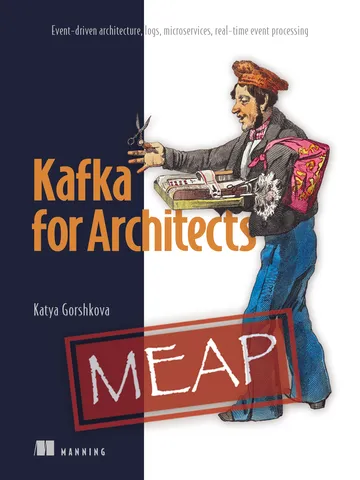Overview
1 Getting to know Kafka as an Architect
Modern architects are moving from brittle point-to-point integrations toward event-driven systems that decouple producers from consumers and turn real-time data into immediate action. This chapter positions Apache Kafka as the backbone for that shift: a durable, high-throughput event streaming platform that fans out events to many consumers with low latency, enabling use cases such as fraud detection, personalized experiences, and operational automation. Rather than focusing on code, the chapter frames the architectural choices—fit, event design, patterns, and governance—that determine sustainable Kafka adoption.
From an architect’s perspective, the move from synchronous request-response (e.g., REST) to event-driven architecture (EDA) trades tight coupling for autonomy and resilience. Services publish events about state changes; interested consumers react asynchronously, tolerate downtime, and scale independently. This freedom introduces new responsibilities: handling eventual consistency, idempotency, and ordering, while balancing latency and operational overhead against business needs.
Kafka’s core builds reliability through a distributed cluster of brokers and a log-centric storage model. Producers write messages that are durably persisted and replicated; consumers pull and can replay data, enabling recovery and reprocessing. Delivery is governed by acknowledgments and retention policies. Cluster metadata and coordination are managed by controllers (KRaft), ensuring high availability through leader election and fault detection. The commit log underpins immutability and ordering, turning streams of changes into a source of truth that can be rewound.
Treating data as a contract is central. Schema Registry externalizes message structure and versioning, enforcing compatibility while keeping brokers fast and schema-agnostic. Kafka Connect moves data between Kafka and external systems via configurable connectors, reducing custom code for ingestion and delivery. For transformation and routing, streaming frameworks (such as Kafka Streams or Flink) implement stateless and stateful operations, joins, and exactly-once workflows—placing business logic in a dedicated processing layer instead of bloating producers or consumers.
Operationally, the chapter highlights sizing (topics, partitions, replication), monitoring, security, and governance as first-order design concerns. Teams must weigh on-premises control against managed-cloud convenience, considering performance tuning, upgrade cadence, tooling limits, and total cost of ownership. Finally, it clarifies where Kafka fits: both as a reliable message backbone and as an event store for patterns like event sourcing, while noting its limits as a general-purpose query engine. The result is a pragmatic lens for deciding when and how to introduce Kafka—and how to guide an enterprise through the organizational and technical changes that follow.
1.10 Summary
FAQ
When should I choose Kafka and event-driven architecture over synchronous request–response APIs?
Kafkas pub-sub model excels when multiple services must react to the same change, when low-latency fan-out is needed, and when data volumes are high. It reduces brittle, chained dependencies and enables autonomous evolution of services. Choose it for real-time use cases like fraud detection, personalization, operational alerts, and when asynchronous resilience matters more than tightly coordinated request flows.What new challenges does an event-driven approach introduce, and how are they addressed?
EDA trades tight coupling for eventual consistency, idempotency, and out-of-order delivery concerns. Architects handle these with local copies of data, careful keying and partitioning for ordering where needed, idempotent consumers, and replay to recover from failures. Accepting temporary divergence and designing for convergence is key.What are the core components of Kafka and how do they interact?
Producers publish messages to topics hosted by brokers; brokers persist and replicate messages for durability; consumers pull (poll) messages from brokers. Applications can be both producers and consumers. Messages are written to disk, and tiered storage can offload older data to cheaper storage while keeping recent data local.How does Kafka provide reliable delivery and fault tolerance?
Producers receive acknowledgments from brokers and retry on failure; brokers persist messages to disk and replicate them across the cluster so another broker can take over on failure. Consumers track progress and can resume after interruptions, and replay allows reprocessing within the configured retention period.What is Kafka’s commit log and why does it matter architecturally?
Kafka appends messages to an ordered, immutable log. This preserves arrival order, supports durable history, and enables replay to rebuild state or recover from errors. Corrections are made by emitting new events, not by mutating or deleting existing ones.How is cluster metadata managed, and what role does KRaft play?
KRaft controllers manage the metadata log, broker registrations, partition assignments, and broker health via heartbeats. One controller is active while others are hot standbys, ensuring fast failover. Servers can run as brokers, controllers, or both; this control plane replaces the need for external coordination in modern deployments.Why do I need a Schema Registry if Kafka brokers don’t enforce structure?
Brokers treat messages as opaque bytes for performance, so structure and compatibility must be managed elsewhere. Schema Registry stores versioned schemas; producers register or reference a schema ID embedded in messages, and consumers fetch the schema to deserialize. Compatibility checks and versioning make evolving contracts safer across teams.What is Kafka Connect, and when should I use it instead of custom code?
Kafka Connect is a configuration-driven framework for moving data between Kafka and external systems using pluggable source/sink connectors. It reduces custom producer/consumer code for common integrations (databases, warehouses, object stores) and runs as its own scalable cluster. Use it to operationalize data pipelines quickly and consistently.Where should transformation or routing logic live in a Kafka-based architecture?
Options include the producer (emit specialized events), each consumer (filter locally), or a dedicated processing layer. Streaming frameworks like Kafka Streams or Apache Flink implement the processing layer, enabling content-based routing, filtering, joins, aggregations, and stateful logic with low latency and exactly-once semantics.Can Kafka replace a database for storing state?
Kafka can retain events indefinitely and serve as the system of record for event-sourcing, letting services rebuild state by replaying change logs. However, it’s not optimized for ad hoc queries or complex filtering, so most architectures pair Kafka with databases or projections tailored to query needs. Think of Kafka as the durable event backbone, not a general-purpose query store. Kafka for Architects ebook for free
Kafka for Architects ebook for free